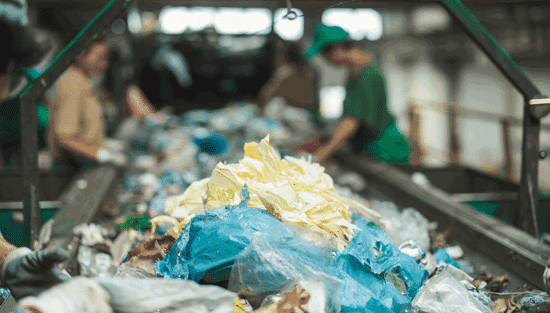How to cut waste with better colour management
Colour management might sometimes feel like a mysterious dark art, but the benefits of using software such as ColorLogic’s suite of products are very real.
Sustainability and waste reduction aren’t just fashionable causes and on-trend ideas. One statement often repeated but powerfully true is that environmental responsibility goes hand-in-hand with commercial efficiency. Waste isn’t just a scourge on an eco level, it’s money that is being lost by your business. And for printers, this problem is often due to incorrect or non-existent colour management.
“One of the greatest causes of waste is when prints don’t meet the customers’ expectations, resulting in reprints. These errors are mainly caused by poor colour management,” ColorLogic’s Product Manager Dietmar Fuchs explains.
“Today the print industry is extremely diverse – there is everything from ceramic printing to wood printing to wallpapers and textiles. But for all those sectors, colour management is very important because there are no single quality standards that you can work with; it’s all individual, and each printer prints colours differently.”

Dietmar Fuchs of ColorLogic
The battle against waste
ColorLogic’s three main products – ColorAnt, CoPrA and ZePrA – work to reduce waste by improving each step of the colour management system.
“Because of the discrepancies in colour presentation, you need to describe how a printer prints colours – that’s what we call characterisation or fingerprinting. You do this by printing a test chart from the printer, which may contain hundreds or even thousands of colour patches that need to be measured with a spectrophotometer. That data is fed into ColorAnt to produce good quality measurement information,” Dietmar says.
“From this information we can build ICC profiles with CoPrA. And with the ICC profiles we can build device link profiles for higher-end quality conversion.
“Then, when you get your print files from a design agency or prepress house, they can be colour converted using our automatic colour server, ZePrA. The colour server ZePrA will match colours throughout your printing process and you can print at a high quality that matches your desired intention.”
Simulation game
As well as improving general accuracy, innovative colour management technology can also reduce waste and improve efficiency with jobs that require specific demands. For example, in the case or multicolour printing or extended colour gamut (ECG) printing, ColorAnt can help to simulate the use of Pantone colours without facing the potential waste created by setting up, printing and cleaning with additional special inks.
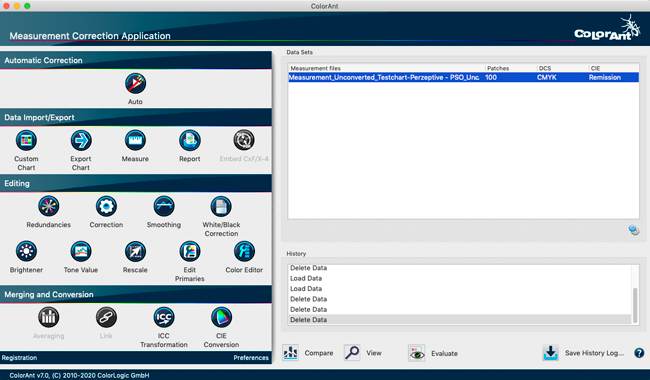
Data from thousands of colour patches can be fed into ColorAnt to produce high-quality measurement information
“Perhaps your client has a certain package that was printed with CMYK. The next time the client says they want to reprint, they may want the magenta switched with a red colour instead. That would typically mean you have to go through the exercise of printing a test chart first on your machine, getting good measurement data, and then creating an ICC profile, which would take a lot of time,” Dietmar says.
“But if you have a measurement already from your desired red, or the client might have that already – from a Pantone colour book, for example – then you can exchange that new process colour in the measurement data that you have already. And by using a standard CMYK plus orange, green and violet – a seven-colour printing process – you can simulate all sorts of colours simultaneously without having to change the inks.
“That is a great ink-saving mechanism because it means you can get several jobs on one sheet with different spot colours. The requirement of course, is that you have good colour management that can do this conversion from Pantone and other spot colours to your printing process.”
The benefits should not just be seen in terms of material and ink waste. If time truly is money, then significant savings and efficiencies can be made here, too.
“The process of printing and making sure the press is in perfect condition, the inks are at the correct level, and so on, before actually printing a characterisation test chart, can easily take one day of work on a big printing press. But this can be avoided by simulating how that red could replace the magenta,” Dietmar says.
“ColorAnt is able to predict how this red will overprint with all the other colours and gives you a simulation of what it would look like. Then you can create an ICC profile from that new virtual measurement data without really printing it on your press – wasting time and ink and paper. And then you could create a proof print to show to a client before working on your press to exchange the red. Or you could even print right away with the profile and the changed ink in the press, saving a lot of time by avoiding creating new fingerprints.”
More black, less waste
In the printing production stage, with CoPrA ColorLogic has introduced another waste-reduction technology: SaveInk.
“CoPrA creates ICC profiles and it also creates SaveInk profiles, which are device link profiles. A device link is a profile that converts from CMYK to CMYK, for example, in one step without having to go through a profile connection space, which is an L*A*B* representation of the colours,” Dietmar says.
“That has a few very important properties because, if you are converting for example 100% black text with a typical ICC printer profile, it goes to LAB first, then it goes to CMYK with the second ICC profile. In the process, it loses the property that it was 100% black – it will be converted to something that is four colours. But a device link can maintain the information that it was a pure colour and it will be a pure colour afterwards.
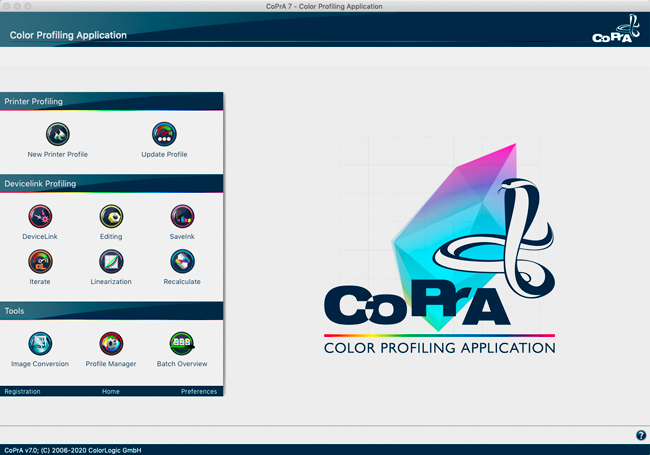
Creating ICC and SaveInk profiles with CoPrA
“In the case of SaveInk technology, it reduces the amount of CMY inks used and replaces it with black, which can reduce ink amounts by an average of 15 to 30%. Most presses need some warming-up time before the correct speed and colour performance is reached, which gives you a pile of waste paper at the beginning. But by using SaveInk, this can be greatly reduced because if you print less ink on your paper it dries faster and sticks better, and therefore the colour is better reached faster on the press, saving a lot of time and material.”
Automatic conversion
When working across a range of different substrates, it may be that a range of different ICC profiles and device links are required. That can be a challenge if you don’t have a workflow that can accommodate it, but ZePrA offers a solution that can reduce both time and effort.
“ZePrA can build the device links on the fly with SmartLink. For example, if it sees it has to convert a file from ISO coated to uncoated in a certain queue and configuration, and then has to convert it to newspaper in another configuration, it will create those device links automatically,” Dietmar says.
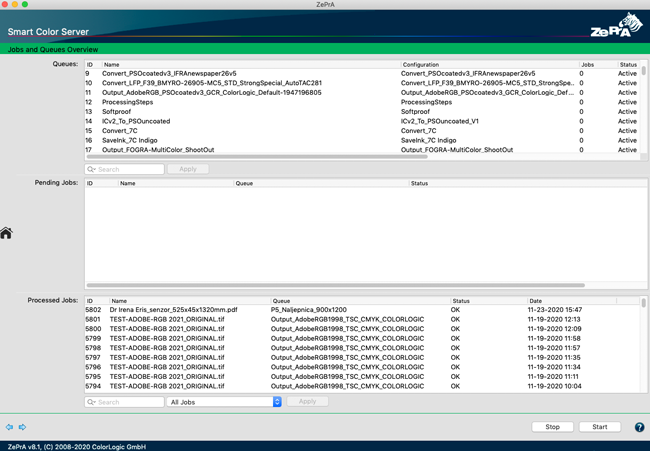
ZePrA automatically reads all ICC profiles and creates the necessary conversions
“In the case of a print-ready PDF document with multiple elements, ZePrA creates device links by looking at all the elements and the output intent, which is basically an ICC profile describing the entire product. There may be RGB images in the document, and each RGB image would then have an ICC profile ascribed to it. But ZePrA reads all the ICC profiles and creates the necessary conversions by building a device link profile for each of those elements and putting them all together. So, you don’t have to do that manually, and that saves you a lot of time.”
ZePrA can even work with PSD and TIFF files with layers from Photoshop.
“Photoshop layers were never designed to do colour conversion. But in the design process and pre-press process, designers like to work with those layers to make last-minute corrections. ZePrA, though, is able to retain most of the layers and convert them, one by one. You can’t do that for all adjustment layers, but it is possible for many. That combines the best of both worlds: you have the colour converted version of your layered file, but you still retain the layers for final editing,” Dietmar says.
“With SmartObjects, that is a more complicated thing, because you can’t convert an Illustrator file that might be liked with the SmartObject, for example – you can’t pick a file that is outside of the original PSD document. But what ZePrA does is convert that SmartObject into an image layer, so a layer that represents what the SmartObject would contribute to the entire file is still there. Then, it can do the colour conversion and you can see finally how that object would look after the colour conversion. This approach maintains the integrity of your file and your colour conversion, but SmartObjects don’t interfere any more.”
One for all
ColorLogic’s innovations aren’t just for designers, pre-press companies, press houses and printers – major printing manufacturers are also incorporating ColorLogic’s technology into their products.
“We have all this technology in the OEM [original equipment manufacturer] software developer kit that manufacturers can integrate into their own solutions,” Dietmar says. "This ranges from the linearisation of the printer, total area coverage, optimisation, profiling their devices, creating device links, editing, saving ink, up to the high-end spot colour conversion that we have integrated in our end-user tools. We have all this technology in the OEM software developer kit that manufacturers can integrate into their own solutions.”
In the case of Durst, for example, its PPD software company uses ColorLogic technology to integrate colour management into the Durst workflow. Another OEM client – printing solutions developer ColorGATE – bases significant parts of its colour management on ColorLogic technology. “Colour management works best if it is seamlessly integrated into the workflow. All kinds of manufacturers have their own workflows so, to make it easy for them, it’s better to integrate this technology into their product right away rather than having to use it an external application,” Dietmar says.
For those who don’t use machinery with integrated colour management, there is one final way to ensure the final product benefits from ColorLogic technology.
“What I see more and more is companies using digital printers with different kinds of RIPs driving those printers. Often all those RIPs have different integrated colour management. Very often, those printing companies are now disabling the colour management in the RIPs and using ZePrA instead to create the colour management. Not only does ZePrA offer better quality with extra functionalities that RIPs don’t generally have, but it’s easier to maintain the colour management with one common user interface.
“And, of course, ease of use, reduced waste, and enhanced efficiency and accuracy are the ultimate goals that have inspired all of our technology.”
Become a FESPA member to continue reading
To read more and access exclusive content on the Club FESPA portal, please contact your Local Association. If you are not a current member, please enquire here. If there is no FESPA Association in your country, you can join FESPA Direct. Once you become a FESPA member, you can gain access to the Club FESPA Portal.
Topics
Recent news
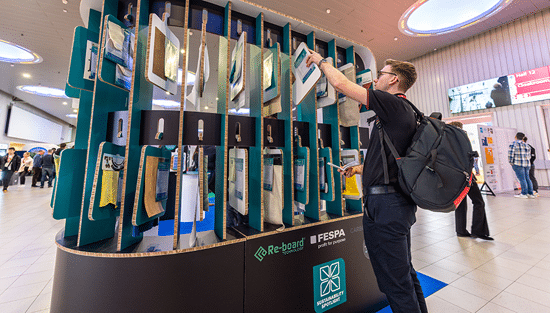
New sustainable materials at Sustainability Spotlight
Sustainability Spotlight returned by popular demand to FESPA Global Print Expo last month in an exhibit curated by The Good Factory.
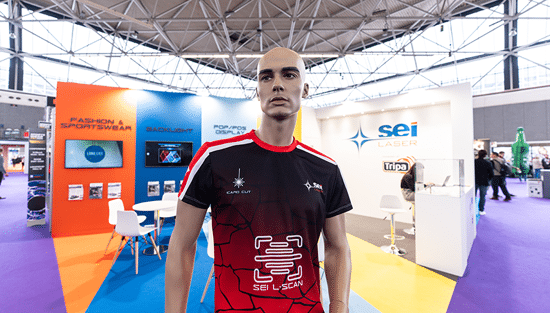
Sportswear Pro: building ‘Brand Me’
After the success of the inaugural Sportswear Pro last month, we spoke with panellist and personalisation expert James Lawrence-Jones about the most exciting revelations at the event.
